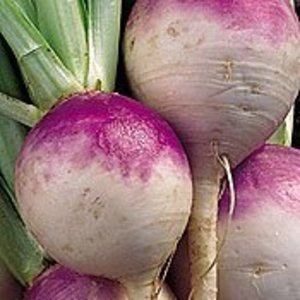Turnips can be grown in most climates. They can be planted in spring and then again in the fall for a second crop. You can plant turnips in a beds or rows. Turnips are often grown for their leafy tops which can be used in soups, stews, salads or boiled with cooked pork, beef or poultry. The distinctively different sharp and delicious flavor of the leaves make turnip greens a favorite ingredient in many Southern recipes.
Choose a sunny part of your garden for turnips. You can grow turnips in beds four feet wide or in rows 12 inches wide and 24 inches apart. Add a good organic compost fertilizer to the soil and mix well. Till the soil to a depth of one foot to allow plenty of room for root development. Turnips like light soil and the compost will lighten the soil and provide a steady supply of nutrients at the same time. The compost also provides for better drainage.
Turnips are usually grown from seeds. If you are growing them for the leaves, sow them thickly and do not thin out. Seeds should be covered with a half inch of soil. If you are growing them for the roots, thin them when they are about three inches tall to allow four to six inches between plants. Add a two inch layer of straw mulch after thinning to help the soil retain moisture. Turnips need plenty of water. Water them lightly every three days in the morning to keep the leaves from wilting. Soil should be kept moist but not soaked.
You can start to harvest the leafy turnip tops when they are three to five inches long–in about three weeks. Clip leaves with scissors or simply pinch them off using the thumb and forefinger. They can be added raw to salads or cooked. If you intend to use the roots, start to harvest when the roots are about three inches in diameter. The roots are ready to harvest in about fifty days. Harvest the roots in the early part of the day when the soil is still moist. Gently loosen the soil with a gardening tool and pull the roots by hand. Peel the fibrous skin off the roots and slice or cube to add them to soups or salads. The Roots can also be eaten raw or cooked and mashed like potatoes.
Turnips contain Vitamins A, C, B6 and E. They are a good source of fiber along with calcium manganese and copper. They also have a good amount of phosphorous, iron and potassium. The leafy tops are more nutritious than the roots.
Turnips have been added to the diet to relieve rheumatoid arthritis. They also promote good colon and lung health. The many vitamins and minerals contained in turnip leaves and roots make it one of the best foods for the healthy growth and development of cells in the human body.
Turnip leaves can be stored for about three days in the refrigerator. The roots can be stored in loose sand in a container in a basement or root cellar. The roots can also be frozen for storage.
Turnips are easy and fun to grow. The roots can be red and white, purple and white, white or yellow in color, depending on the variety chosen. The leaves can be picked in as little as three weeks after planting. The roots are ready for harvest in about fifty days. The delicious flavor of both the leaves and root make the turnip one of the most versatile garden crops.



